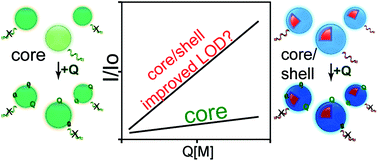Charge carrier pairing can impart efficient reduction efficiency to core/shell quantum dots: applications for chemical sensing†
Abstract
Semiconductor quantum dots (QDs) are bright fluorophores that have significant utility for imaging and sensing applications. Core QDs are often employed in chemosensing via redox processes that modulates their fluorescence in the presence of an analyte. However, such particles lack robust surface passivation and generally contain a sizable portion of nonfluorescent QDs, which is detrimental to the detection limit. We investigated an approach to “turn on” non-fluorescent core QDs by lightly overcoating them with a thin shell of a higher bandgap semiconductor. The shell augments the population of sensing chromophores and increases the emission lifetime; however, it simultaneously mollifies redox processes that are responsible for analyte sensitivity to begin with. This balancing act was successfully applied to enhance the sensitivity of CdZnS/ZnS QDs towards 2,4,6-trinitrotoluene (TNT). Unexpectedly, it was found that CdZnS/ZnS QDs with very thick shells retained substantial sensitivity to TNT. This observation may be due to close coupling of the reduced substrate with the QD hole that is enabled by the near-degeneracy of holes in the core CdZnS and ZnS shell. The ability of core/shell QDs to retain substantial reducing power may have implications for other applications that can benefit from the enhanced stability of robust core/shell nanomaterials.



 Please wait while we load your content...
Please wait while we load your content...